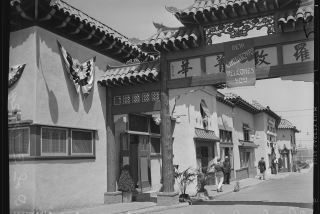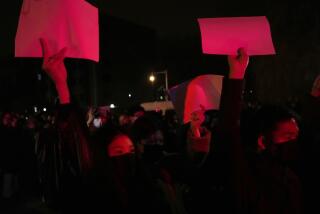Shanghai’s saga continues to unfold
Shanghai — Gritty and crowded, Shanghai has a vibrant street life and a history of intrigue, but most of all it has a proven capacity to reinvent itself -- something I had heard was now happening at a maniacal pace.
The city, home to 15 million, is the heart of China’s burgeoning economic development and has become one of the world’s fastest-changing places as the government heaps millions into the economy and permanently alters the skyline with a host of new skyscrapers.
It has been nearly 10 years since my family and I left Shanghai. When my firm assigned me there in 1988, I regarded the city as a hardship posting: It had foul air and a byzantine business climate, and it was under communist rule. But when I left five years later, my attitude was changing, and so was this city on the Yangtze River Delta.
What is Shanghai like today? We decided to retrace our steps as expatriates, discovering the profound changes that, we heard, were restoring Shanghai as East Asia’s preeminent capital of commerce and culture.
My wife, Lynn, teenage daughter, Lindsey, and I arrived at Shanghai’s new Pudong Airport in late August. Our taxi crossed the Huangpu River, delivering us into the city. On the right was the new Pudong “special economic zone”; on the left, the Bund, the row of Old World buildings and banks that remain from Shanghai’s heyday.
We were dismayed to see that so much of the old city had been leveled to make way for skyscrapers. But we remembered what the city once was and envisioned it unfolding, block by block, one age merging into the next, as we taxied west and back in time. From the Bund, the heart of the onetime international settlement, we traversed what remains of the French Concession; Shanghai’s nickname, “Paris of the Orient,” stems from this area’s graceful tree-lined avenues and Gallic style of architecture. Continuing back in time, we entered the Jing An district with its Ching- and Ming-era temples.
A series of reincarnations
Shanghai, which translates to “above the sea,” was an outpost for the cotton trade until the British won the Opium Wars in 1842, forcing China open to international commerce. The city, at the juncture of the Yangtze and the Pacific, became the fulcrum of business activity in the region. Autonomous foreign settlements were formed, business flourished and the glamorous assembled. Shanghai became both the “Paris of the Orient” and a capital of vice.
The city’s decline came with the World War II Japanese occupation, the civil war and Communist takeover in 1949. Shanghai transformed itself into a communist urban model. And with the death of Mao Tse-tung and the emergence of the more moderate Deng Xiaoping in the early 1980s, Shanghai reincarnated again, evolving into a free trade and tourism powerhouse.
A good night’s sleep was on our minds when we arrived at the glittery Portman Ritz-Carlton Hotel, in the Shanghai Centre complex. Opened in 1990, the Centre instantly became a symbol of a new and reemerging Shanghai. It is a 50-story city-within-a-city catering mainly to the foreign community, developed by Atlanta architect John Portman. There are two apartment towers, a retail mall, a theater, the hotel and U.S.-style businesses such as Starbucks and the Hard Rock Cafe. We lived in an apartment there in the early ‘90s.
Climbing out of the taxi, we experienced a familiar sensation: Shanghai’s oppressive August humidity. After checking into our small but elegant room, we dropped into the Long Bar, a favorite expatriate hangout on the second level of the complex. Still displayed above the bar were small plaques commemorating some of its first patrons, among them Reagan-era Cabinet members Caspar W. Weinberger and Alexander M. Haig Jr.
Our first morning, in 90-degree heat, we walked a few blocks west on Nanjing Road to the Jing An subway station, opened in 1999. It was easy to use and even provided helpful signs in Chinese and English, like “Do not leap into the tunnels.” Two stops and 17 cents later, we exited the Renmin Park station bound for People’s Square.
Nearby is the new Urban Planning Exhibition Hall, the perfect place to become oriented to Shanghai’s past, present and future. This modern building, which resembles an ancient Chinese pavilion about to take flight, features a pictorial history of Shanghai’s architecture and a Disney-like “main street” with a traditional Chinese pharmacy, teahouse and other reminders of what Shanghai was like not so long ago. But the most fascinating feature is a massive scale model of the city. Studying it, one senses the monumental scale of current construction.
Leaving the Exhibition Hall, we crossed People’s Square to the Great World complex to take another look at Shanghai’s more recent past. In an infamous spasm of debauchery, Great World opened in the 1920s as a sort of one-stop shop for all imaginable vices. It began innocently enough on the lower floor of the six-story building with acrobats and magicians. On upper floors were gambling, drugs, prostitution and ever more exotic pleasures. Great World now reflects China’s egalitarian mores: It has become a slightly cheesy amusement arcade with carnival games and magic shows. We doubled back to People’s Square and the new Shanghai Museum for a look into ancient China. I found myself using the word “exquisite” frequently as I strolled through the four floors of galleries. The museum owns one of the world’s great collections of Chinese art and artifacts. Bronze vessels in immaculate condition, dating to the 18th century BC, are beautifully displayed. There are also ceramics, paintings, porcelains, furniture, costumes and other artifacts from the Tang, Song, Ming and other dynasties.
For dinner we chose an old favorite, the Jin Jiang Hotel. At its 12th-floor Si Chuan Restaurant, we decided against bullfrog, stewed snake and “mixed internal organs of beef.” Instead we ordered steamed dumplings (xiao lomba) and tofu with chili sauce (mapu dofu), all very spicy. We recalled that right across the way, Henry A. Kissinger and Chou En-lai signed the Shanghai Communique in 1972, establishing diplomatic relations.
Renovation boom
The following day, several friends hosted lunch at Zhiweiguan, a Hangzhou-style restaurant in the Jing An district. The lotus stuffed with glutinous rice was pleasantly sweet, and the “drunken chicken” was moist and delicious. We reminisced about the old days, when recreational opportunities were scarce. So our friends flagged taxis, and, after a few minutes, a splash of colorful banners announced the new Xintiandi area, a once rundown neighborhood that has gentrified into a chic entertainment center. Buildings that decayed for decades have been renovated to house restaurants, nightclubs, galleries and boutiques.
The next day, our daughter settled in at our hotel room to e-mail friends while my wife and I caught the subway. At the Bund History Museum at the north end of Huangpu Park is a brief pictorial history of the area. There at the confluence of Suzhou Creek and the Huangpu River, the entire Bund is visible, as is the Pudong New Area across the river with its garish Pearl of the Orient TV tower, Asia’s tallest structure. Strolling Zhongshan Road on the Bund, we stepped into the Industrial and Commercial Bank, originally Jardine Matheson & Co., whose lobby has been restored to its original white marble and gilt splendor. We moved on to the Hong Kong Shanghai Bank, now the Pudong Development Bank. High up in the entry dome, layers of paint were removed to reveal an elaborate mosaic picturing the world’s trading capitals, the zodiac and scenes from Greek mythology, another reminder of Shanghai’s 1920s opulence.
We took a breather from the heat at the famous Peace Hotel, musing that Noel Coward wrote “Private Lives” here in 1930. Then we returned to the subway on the way to Pudong, on the other side of the river, and its Grand Hyatt Hotel, which resembles an 88-story pagoda. Visitors can pay for passage to the top-floor observation deck. But we relaxed in the 54th-floor lobby, sipped iced tea and coffee and looked out on Pudong, the Bund, the river traffic and the murky afternoon sky.
We wanted to spend some time in our old neighborhood, so we checked out of the five-star Ritz and into the three-star Donghu Hotel, in the heart of the Luwan district, formerly called the French Concession. An apartment in the hotel was our first home in Shanghai.
Though a little musty, our two-room suite was comfortable and clean, and it cost a third as much as our elegant room at the Ritz.
Most major international performances are now held at the new 1,800-seat Grand Theatre in People’s Square, but there is much to see on other stages too. One night we saw the touring European Philharmonie at the 1,001-seat Shanghai Centre Theatre; another night we attended a kung fu exhibition featuring the monks of China’s Shaolin Temple at the spectacularly restored 1930s-era Majestic Theatre.
Our final morning, I went jogging along my former four-mile route, from the Donghu to Huaihai Road. Arriving at Hengshan Road, I passed a former residence of Chiang Kai-shek, richly renovated into a popular Continental restaurant, Sasha’s.
A little farther on, the Community Church, a charming Tudor structure, was filled to capacity for the 8 a.m. service. My daughter was baptized there on Easter in 1989. I was warmly welcomed by a Chinese usher and asked to join the overflow crowd in the lush garden, but I jogged on.
Behind the Hengshan Hotel, I heard a Viennese waltz and investigated a scene fit for a Renoir. Smartly dressed couples drifted in circles, enjoying the genteel Shanghai exercise ritual of ballroom dance. As rays of dusty sunlight beamed through the dome of leaves, I wondered if scenes like this will still exist the next time I return to Shanghai.
*
(BEGIN TEXT OF INFOBOX)
Rediscovering Shanghai
GETTING THERE:
From LAX: China Eastern offers direct service (at least one stop but no change of planes); connecting service (change of planes) is available from Japan Airlines, ANA, United, Air Canada, Thai, Northwest and Air China. Fares begin at $1,299.
TELEPHONES:
To call the numbers below from the U.S., dial 011 (the international dialing code), 86 (country code for China), 21 (local area code) and the number.
WHERE TO STAY:
Portman Ritz-Carlton, 1376 Nanjing Xi Lu, Shanghai; (800) 241-3333, www.ritzcarlton.com. This elegant hotel is in the extensive Shanghai Centre complex. Doubles from $190.
Grand Hyatt Pudong, Jin Mao Tower, 88 Century Blvd., Pudong; (800) 233-1234, www.hyatt.com. This is the highest hotel in the world, located on the 53rd to 87th floors of the Jin Mao Tower. It offers a spectacular view of the Bund and Huangpu River traffic. Doubles $218-$360.
Donghu Hotel, 70 Donghu Road, Shanghai; 6415-8158. This hotel offers an economical taste of the old French Concession. Doubles from $70.
WHERE TO EAT:
Si Chuan Restaurant, Jin Jiang Hotel, 12th floor of North Building, 59 Mao Ming South Road, 6258-2582. Traditional Chinese cuisine. Dinner about $12.
Zhiweiguan, Jing An district, 5298-7768. Appetizers $2-$5, main courses $7-$15. Hangzhou-style cooking, including traditional Zhejiang Province specialties: various lotus dishes, sweet cabbage, vinegar fish and dong po pork.
Sasha’s, 9 Dongping Lu, 6474-6166. Indoor and outdoor “colonial” dining and extensive wine list in Chiang Kai-shek’s restored former residence. Three-course set dinner is $22-$30.
Shanghai Centre, 1376 Nanjing Xi Lu. Numerous excellent restaurants are in the complex, featuring Chinese, Japanese, Italian and other cuisines.
TO LEARN MORE:
China National Tourist Office, 600 W. Broadway, Suite 320, Glendale, CA 91204; (818) 545-7507, fax (818) 545-7506.
More to Read
Sign up for Essential California
The most important California stories and recommendations in your inbox every morning.
You may occasionally receive promotional content from the Los Angeles Times.










